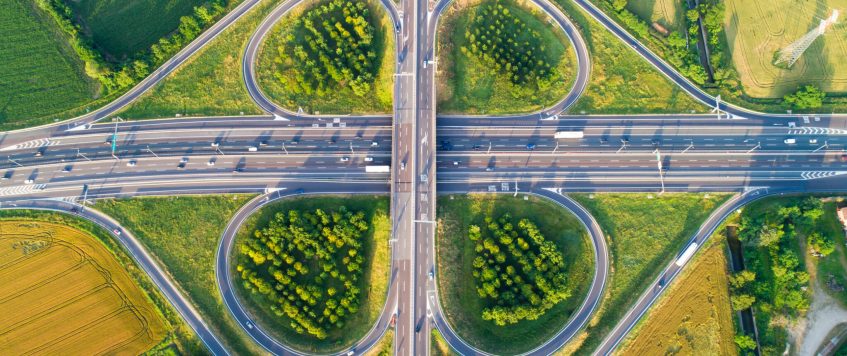-
17
Mar
Worst cloverleaf interchanges in US
To celebrate St. Patrick’s Day, we wanted to know which cloverleaf highways truckers hate the most (see what we did there?).Based on a survey of Covenant Transport and Landair drivers, these are four of the interchanges they called out the most. Apparently, the luck of the Irish doesn’t help much on these roads.
Cobb Cloverleaf, Atlanta

Atlanta: I-75 and I-285 (Google maps) The Cobb Cloverleaf is an interchange just northwest of downtown Atlanta. It’s in Cobb County, east of Smyrna and west of Sandy Springs. The highways at the interchange are Interstates 75 and 285. Despite the name, the interchange has only two cloverleaf-style ramps. The Georgia Department of Transportation (GDOT) has posted signage on I-75 officially referring to the interchange as the Emory Parrish Interchange.
The WSB-TV Skycopter traffic team has noticed Cobb Cloverleaf traffic delays that initially made no sense. The feeder ramp that runs from Cobb Parkway and the I-75 ramps to I-285 eastbound used to back up very often before the COVID-19 outbreak. The team didn’t see any part of that one-lane ramp blocked, nor did they see anything on I-285 eastbound ahead of the ramp that would delay traffic.
Eventually, they chalked it up to blind adherence to GPS app directions. Turn-by-turn voice instructions often direct people to make a redundant maneuver, when saying “stay straight” would have sufficed.
Tom Moreland Interchange in Atlanta (Photo: Public Domain)Tom Moreland Interchange, Atlanta
Atlanta: I-85 and I-285 (Google maps) The Tom Moreland Interchange, colloquially known as Spaghetti Junction, is in northeastern Atlanta, just south of Norcross. It’s in Dekalb County and marks the intersection of Interstates 85 and 285, along with several access roads. Moreland was a commissioner of GDOT from 1975 to 1987. The I-85 corridor is a high-traffic route from the northeastern suburbs of Atlanta into the downtown area, while I-285 is a beltway around the city. In the northern I-285 corridor, in the area from I-85 counterclockwise to I-75, there has been a large amount of business growth over the past few decades, with increasing traffic to go along with it.
Spaghetti Junction was designed to remove chokepoints and reduce congestion in the I-85 and I-285 interchange, which had been a true cloverleaf.
The American Transportation Research Institute (ATRI) recently ranked the Tom Moreland Interchange as the third worst bottleneck in the country for truckers.
Stemmons Freeway at Lyndon B. Johnson Freeway, Dallas

Dallas: I-35E and I-635 (Google maps) This marks the interchange of Interstate 35E (Stemmons Freeway) and Interstate 635 (Lyndon B. Johnson Freeway) in Dallas, and the interchange has one cloverleaf on the northeast side. The Stemmons Freeway was named for Leslie Stemmons, a late influential businessman in Dallas. It’s currently the widest freeway in the Dallas-Fort Worth metroplex. It has 16 total lanes, 10 lanes of high-speed freeway and six lanes of access roads on a 10-mile stretch. The I-35E corridor is one of the most congested freeways in the country.
The Lyndon B. Johnson Freeway is a 37-mile-long partial loop around Dallas, between Interstate 20 in Balch Springs and State Highway 121 at Dallas-Fort Worth International Airport. It intersects I-35E just northwest of downtown. The road is named after the former U.S. senator from Texas, 37th vice president and 36th president of the United States.
Judge Harry Pregerson Interchange in Los Angeles (Photo: Shutterstock)Judge Harry Pregerson Interchange, Los Angeles

Los Angeles: I-105 and I-110 (Google maps) The Judge Harry Pregerson Interchange is a stack interchange, with one cloverleaf feature, near the Athens and Watts communities of Los Angeles. Its main highways include Interstates 105 and 110, and it is more than 130 feet high. The interchange is named after a longtime federal judge who presided over the lawsuit concerning the I-105 freeway’s construction. Drivers entering the interchange on the freeway trunks from all directions have freedom to exit the interchange in all possible directions of travel. In other words, it’s a complete interchange.
Nearly all ramps are direct — an inherent advantage of the stack interchange design — and can be driven at near-mainline speeds when not congested. The main exception is the ramp from northbound I-110 to westbound I-105, which is a cloverleaf loop.
However, with a metropolitan population of more than 13 million in Los Angeles, traffic is still inevitable. Many truckers say that this interchange is bad, even on a good day.
By Nick Austin at Freighwaves

